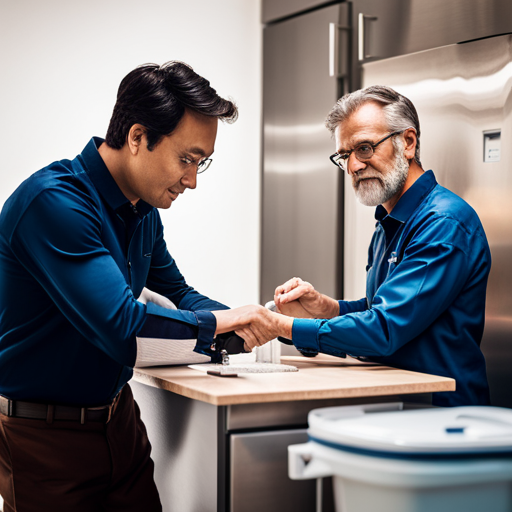Are you tired of experiencing poor water flow or a strange taste from your Whirlpool refrigerator’s water dispenser? It’s time to troubleshoot your water filter. Don’t worry, with our guide, you can easily identify and solve most filter-related issues.
The first step in troubleshooting your Whirlpool fridge’s water filter is to understand how to replace it. Our article will guide you through the process, including how to choose the right replacement filter and the steps to take to change it.
We’ll also cover common issues that can affect water flow, such as control lock activation, and provide solutions to these problems. By following our tips, you’ll be able to enjoy refreshing, filtered water from your fridge once again.
So, let’s get started on fixing those filter problems!
Key Takeaways
– Regularly replacing the water filter every 6 months or as needed is crucial for optimal performance
– Choosing the right replacement filter and following proper installation steps is important
– Checking for dispensing errors, low water pressure, or frozen water lines is necessary
– Using genuine replacement parts and consulting the user manual for specific instructions is recommended.
Water Filter Replacement
If you’re experiencing reduced water flow or a strange taste, it might be time to replace your Whirlpool fridge’s water filter. The filter should be replaced every 6 months or more frequently in areas with high water contaminants.
To ensure you choose the right replacement filter, look for the water filter number and choose a genuine replacement part. Choosing the wrong filter can cause issues and affect the quality of your water.
When replacing the water filter, locate it in your fridge, remove the old filter, prepare the new filter, align and insert it, and flush the system. Keep in mind that the control lock function will activate during filter replacement, which can be deactivated by holding the lock icon.
After replacing the filter, be sure to reset the water filter light. If you follow these steps, you can easily troubleshoot your Whirlpool fridge’s water filter and enjoy clean, fresh water and ice.
Control Lock Activation
To deactivate the control lock on your refrigerator, simply hold down the lock icon for three seconds until the light turns off. The control lock function is activated during water filter replacement to prevent unintentional changes in the fridge’s settings.
However, if the lock function remains activated even after filter replacement, it can be frustrating when you can’t use your water dispenser or ice maker. If you’re having trouble with control lock activation, try unplugging your fridge for a few minutes and plugging it back in. This can reset the system and deactivate the lock function.
If this doesn’t work, check your user manual for specific instructions on how to troubleshoot control lock activation. In most cases, simply holding down the lock icon for three seconds will do the trick.
Remember to reset the water filter light after replacement and enjoy fresh, clean water and ice from your Whirlpool fridge.
Common Issues and Solutions
You can easily solve most issues that may arise with your refrigerator’s filtration system by checking for dispensing errors, low water pressure, or frozen water lines. If you notice reduced water flow or a strange taste in your water, it may be time to replace your water filter. However, if you’ve already replaced the filter and these issues persist, there may be other underlying causes.
To troubleshoot reduced water flow or a strange taste, start by checking the dispensing process. Make sure the dispenser isn’t blocked or clogged, and that the water line isn’t kinked or damaged. If that doesn’t solve the issue, check the water pressure to ensure it isn’t too low.
If the water pressure is normal, then the issue may be a frozen water line or a door that isn’t closing properly. By identifying and addressing these common issues, you can ensure your refrigerator’s filtration system is working properly and providing you with clean, fresh water.
Conclusion
Congratulations! You’ve successfully troubleshooted your Whirlpool fridge water filter and can now enjoy clean and refreshing water once again.
Remember to replace your filter every six months or as recommended by the manufacturer to ensure optimal performance and avoid potential issues.
To recap, we’ve covered the steps to choose the right replacement filter, how to change the filter, and common issues that can affect water flow. By following these tips, you can save time and money by avoiding unnecessary service calls and keeping your fridge in top condition.
Now sit back, relax, and enjoy the refreshing taste of clean water from your Whirlpool fridge. Cheers!
